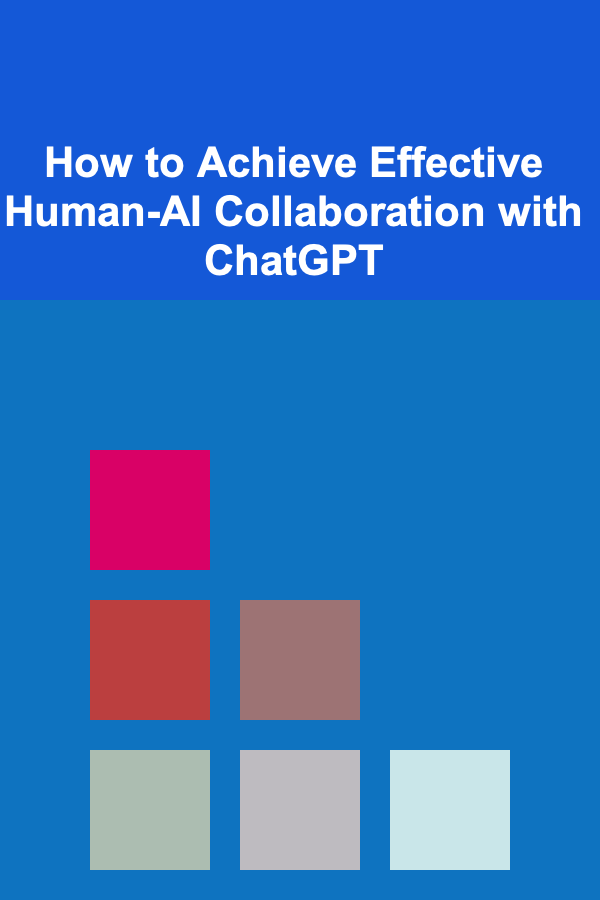
How to Achieve Effective Human-AI Collaboration with ChatGPT
ebook include PDF & Audio bundle (Micro Guide)
$12.99$5.99
Limited Time Offer! Order within the next:

Human-AI collaboration is becoming increasingly central to industries ranging from healthcare to education, from creative fields to customer service. As artificial intelligence continues to evolve, tools like ChatGPT are playing a crucial role in augmenting human abilities and helping streamline tasks, solve complex problems, and facilitate decision-making. However, to maximize the potential of ChatGPT in collaborative settings, it's essential to understand how to effectively integrate AI into human workflows and harness its full potential.
The Importance of Human-AI Collaboration
AI tools, such as ChatGPT, can perform tasks that involve processing vast amounts of data, automating repetitive processes, and offering insights based on learned patterns. However, AI systems like ChatGPT do not possess emotional intelligence, personal experience, or intuition. This is where humans bring significant value: the ability to understand context, think creatively, and make ethical decisions. Together, humans and AI can complement each other's strengths and achieve better outcomes than either could independently.
Human-AI collaboration works best when AI acts as an assistant, providing humans with the tools they need to accomplish tasks more efficiently and effectively. In this collaboration, humans remain in control, making final decisions, offering judgment, and guiding the AI's actions. To get the most out of AI tools like ChatGPT, users must understand both the capabilities and limitations of these systems.
Understanding ChatGPT's Capabilities and Limitations
Before diving into strategies for effective collaboration, it's essential to understand what ChatGPT can do and where it may fall short.
Capabilities
- Text Generation: ChatGPT excels in producing text-based content in various forms, from answering questions to writing essays, articles, and creative pieces. It can generate text quickly, saving users significant time.
- Summarization: ChatGPT can summarize long documents, articles, or research papers, helping users save time by distilling information into key points.
- Information Retrieval: By processing large amounts of data, ChatGPT can provide users with relevant insights or point to additional resources that can help answer questions or solve problems.
- Language Translation: ChatGPT supports translation between multiple languages, breaking down language barriers in communication.
- Conversational Assistance: ChatGPT can engage in natural language conversations, making it ideal for chatbots or customer service applications.
- Personalization: ChatGPT can adjust its responses based on user preferences, allowing for personalized communication in many different contexts.
Limitations
- Lack of Emotional Intelligence: While ChatGPT can simulate conversational nuances, it does not understand emotions or have empathy. This makes it less suitable for tasks that require emotional sensitivity.
- Dependence on Training Data: ChatGPT's knowledge is limited to the data it was trained on, which means it can become outdated or offer incorrect information, particularly on very recent events.
- Contextual Understanding: While ChatGPT can respond to questions or prompts based on the context provided, it may struggle with highly nuanced or complex situations that require deep contextual understanding.
- Creativity and Ethics: AI lacks true creativity and ethical reasoning. It can generate creative content based on patterns, but it cannot innovate in the same way a human can. Furthermore, it may inadvertently produce biased or unethical content if not properly guided.
How to Achieve Effective Collaboration
Given the strengths and limitations of ChatGPT, achieving effective human-AI collaboration requires a thoughtful approach. Here are some strategies to optimize the use of ChatGPT in various domains:
1. Define Clear Roles for AI and Humans
The foundation of successful human-AI collaboration is a clear delineation of roles. AI tools like ChatGPT should be used to assist with tasks that involve processing information, automating repetitive activities, and generating content. However, humans should remain responsible for decision-making, ethical considerations, and tasks requiring emotional intelligence and creative problem-solving.
For instance, in content creation, ChatGPT can help generate drafts or outlines, but the human user is responsible for refining the tone, adding personal insights, and ensuring that the content aligns with ethical standards.
2. Incorporate Human Judgment and Context
While ChatGPT can generate responses based on patterns in the data it has been trained on, it lacks the ability to understand the intricacies of a specific context. Humans should ensure that the output generated by ChatGPT is aligned with the particular situation at hand. For example, in healthcare, a doctor may use ChatGPT to analyze a patient's medical history, but it is ultimately the doctor who will interpret the data and make a diagnosis.
Human input is especially critical when it comes to tasks that involve subjective judgment, creativity, or context that goes beyond data. This might involve choosing between different responses generated by ChatGPT based on the desired tone or interpreting ambiguous information.
3. Leverage ChatGPT's Strengths in Repetitive and Time-Consuming Tasks
AI tools like ChatGPT can greatly enhance productivity by handling time-consuming or repetitive tasks. For example, in research, ChatGPT can sift through large volumes of text, summarize articles, or identify key trends, freeing up time for the researcher to focus on deeper analysis or creative work. Similarly, in customer service, ChatGPT can handle initial queries, offering quick responses to common questions, while human agents can focus on more complex or sensitive cases.
Using ChatGPT to streamline these tasks allows humans to focus their energy on higher-order problem-solving, creative endeavors, or decision-making.
4. Create Feedback Loops to Improve Results
Effective collaboration involves continuous improvement. One way to enhance human-AI collaboration is by creating feedback loops where users regularly assess and adjust the AI's output. For example, if a content creator uses ChatGPT to generate a blog post draft, they can provide feedback on the style, tone, and clarity of the content. Over time, this feedback can be used to refine the user's prompts and guide ChatGPT to produce better results.
Additionally, humans can use the feedback loop to identify areas where ChatGPT may need further development or correction, particularly in cases where it produces outdated or inaccurate information.
5. Utilize AI for Ideation and Inspiration
While ChatGPT may not possess the creativity of a human, it can serve as a powerful tool for brainstorming and idea generation. Writers, marketers, and designers can use ChatGPT to explore new perspectives, identify trends, or generate fresh ideas. ChatGPT can produce lists of possible directions, suggest keywords, or even offer unconventional solutions that humans might not have considered.
Using ChatGPT for ideation allows individuals to rapidly generate a wide array of possibilities, which can then be refined and developed by the human collaborator. This collaborative process fosters creativity and innovation while maximizing the efficiency of the brainstorming phase.
6. Maintain Ethical Oversight
One of the significant challenges with AI tools like ChatGPT is ensuring that they operate ethically. While AI can generate content and perform tasks efficiently, it may inadvertently produce biased or harmful outputs if not properly guided. Humans must ensure that the output from ChatGPT aligns with ethical standards, particularly when dealing with sensitive topics such as healthcare, finance, or social issues.
To maintain ethical oversight, it's crucial to regularly review AI-generated content, apply checks for bias, and intervene when necessary to ensure that the results adhere to social, cultural, and ethical norms. Human responsibility is essential in preventing AI from perpetuating stereotypes or harmful narratives.
7. Develop Long-Term Collaborative Strategies
For long-term success, organizations and individuals need to develop comprehensive strategies for human-AI collaboration. This includes investing in training and education to ensure that users understand how to effectively use AI tools and integrate them into their workflows. It also involves creating a culture that embraces the complementary nature of human-AI partnerships rather than viewing AI as a replacement for human workers.
Training programs can teach users how to craft effective prompts for ChatGPT, how to interpret AI-generated results, and how to guide the AI toward more accurate or creative outputs. By establishing a framework for long-term collaboration, organizations can ensure that they are maximizing the potential of both human and AI capabilities.
Real-World Applications of Human-AI Collaboration with ChatGPT
Human-AI collaboration with ChatGPT can be applied in various real-world scenarios across multiple industries. Here are a few examples:
1. Content Creation and Marketing
In the field of content creation, ChatGPT can assist writers, marketers, and journalists by providing initial drafts, summarizing information, and offering creative ideas. By working together with ChatGPT, content creators can produce high-quality content faster while ensuring that the final output is aligned with their brand voice and objectives.
2. Healthcare and Medical Research
In healthcare, ChatGPT can assist researchers and doctors by processing large volumes of data, identifying patterns, and generating potential hypotheses. However, human expertise is still necessary to interpret the findings and make critical decisions, ensuring that patient care remains at the forefront.
3. Customer Support
ChatGPT is already being utilized in customer support roles, handling routine inquiries and providing quick responses. Human agents can then focus on more complex or emotionally sensitive issues, ensuring that the customer receives a seamless and personalized experience.
4. Education and Tutoring
ChatGPT can act as an educational assistant, offering explanations, answering questions, and providing study materials. Instructors can use ChatGPT to enhance the learning experience by creating personalized lesson plans and responding to students' queries in real time.
Conclusion
Achieving effective human-AI collaboration with ChatGPT requires an understanding of both the tool's capabilities and limitations. By leveraging ChatGPT for repetitive tasks, ideation, and information processing while ensuring human oversight for decision-making, ethical considerations, and creativity, we can unlock the full potential of this collaboration. Through continuous feedback, training, and developing clear roles, we can ensure that ChatGPT serves as a powerful assistant that enhances human abilities and fosters greater innovation across various industries.

How to Create a Family Photo Album Together
Read More
How to Get Rid of Common Household Odors Naturally
Read More
How to Organize Your Digital Photos for Quick Retrieval
Read More
How to Regularly Inspect Your Home Appliances
Read More
How to Showcase Kids' Artwork Without the Mess
Read More
How to Use Smart Locks to Enhance Your Home's Security
Read MoreOther Products

How to Create a Family Photo Album Together
Read More
How to Get Rid of Common Household Odors Naturally
Read More
How to Organize Your Digital Photos for Quick Retrieval
Read More
How to Regularly Inspect Your Home Appliances
Read More
How to Showcase Kids' Artwork Without the Mess
Read More